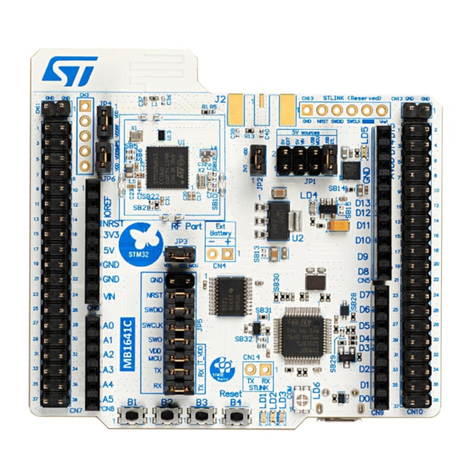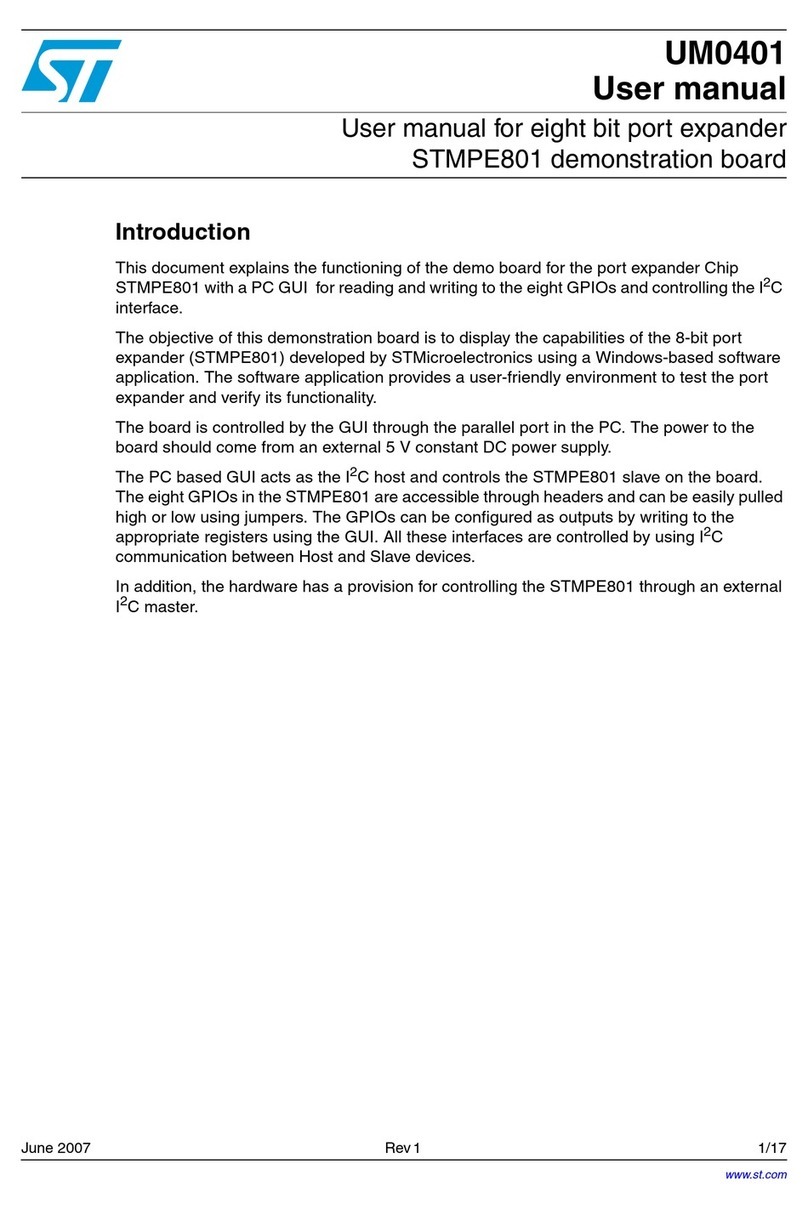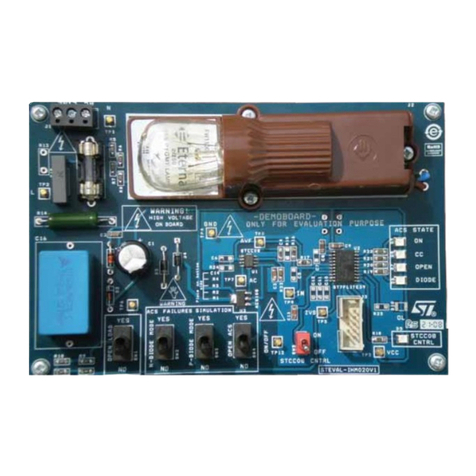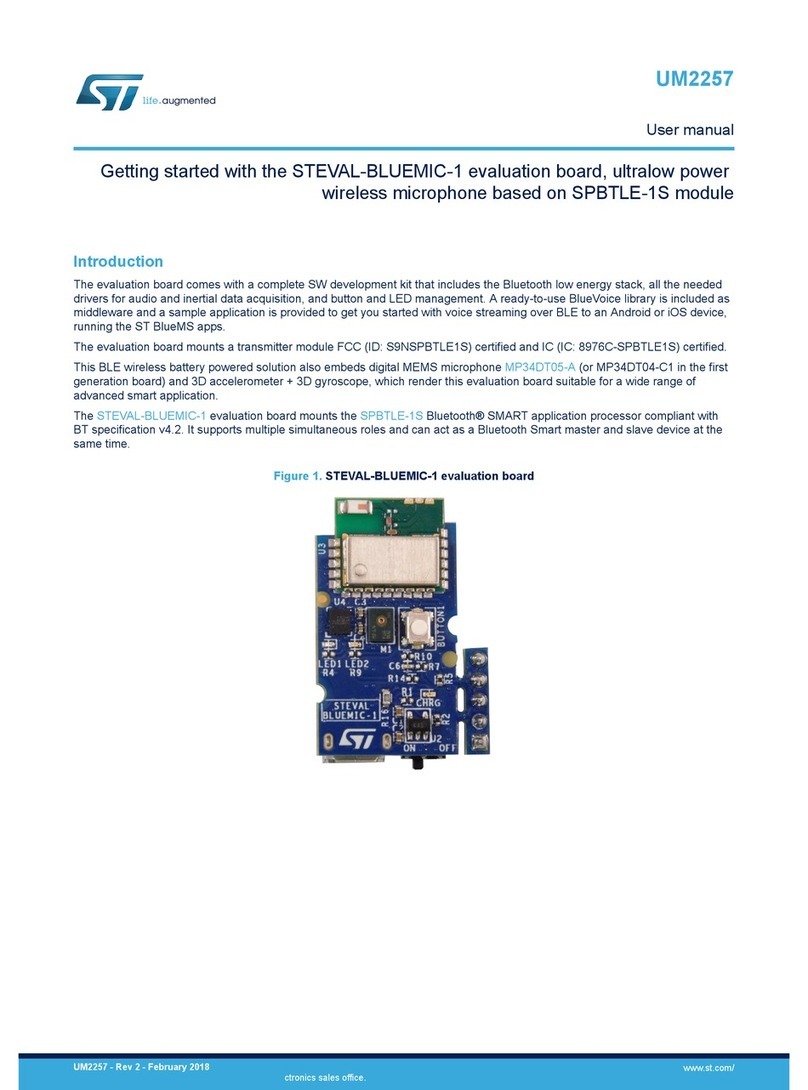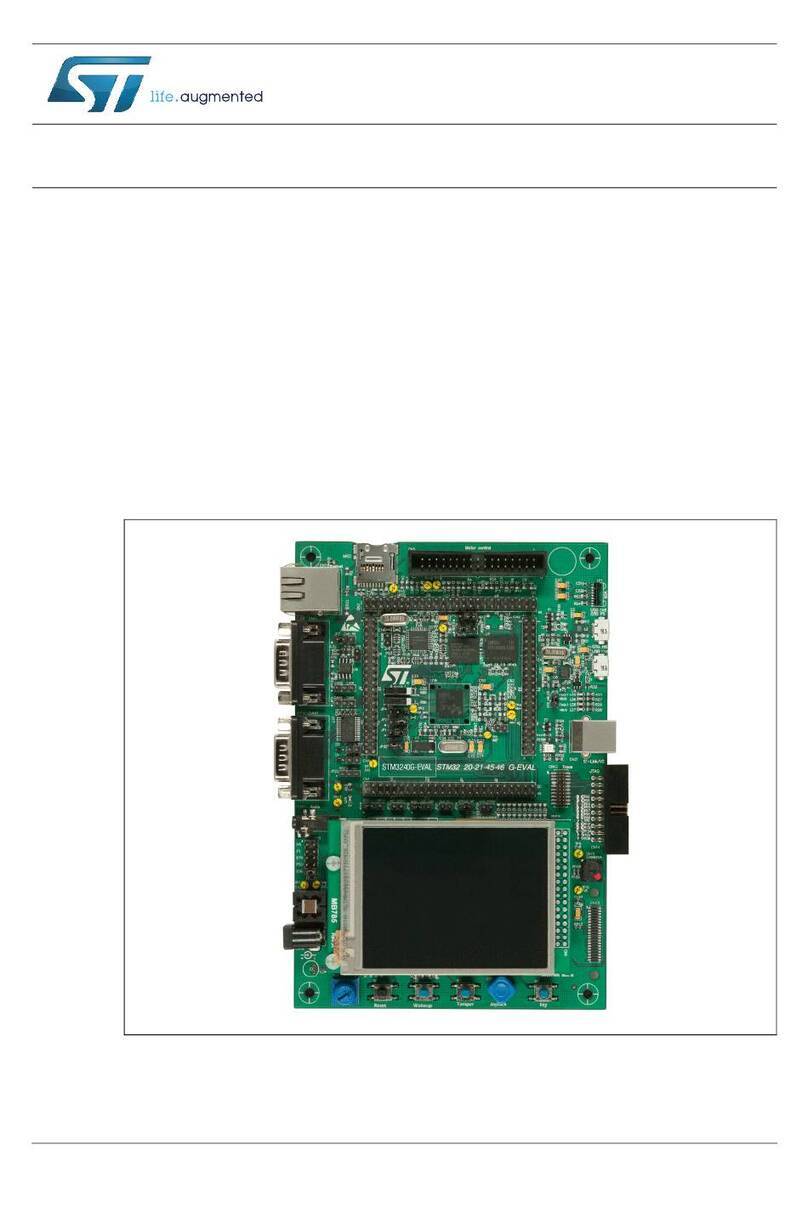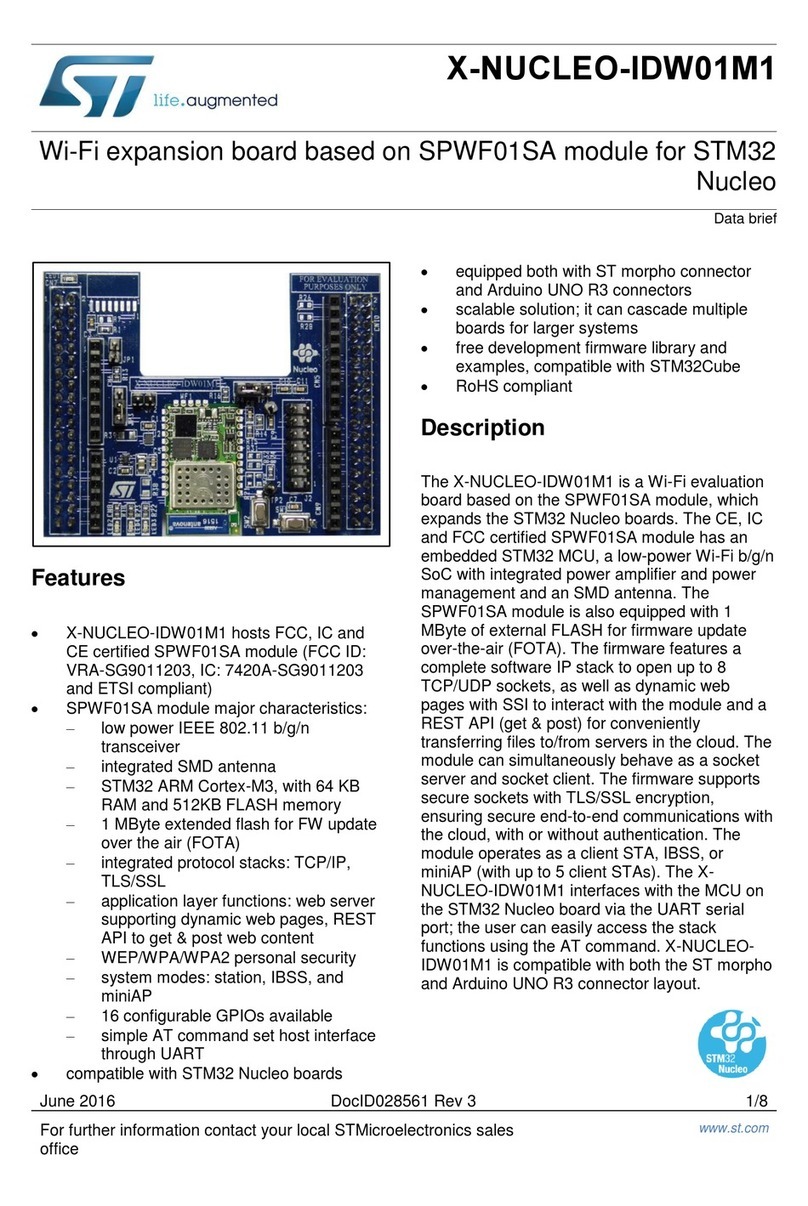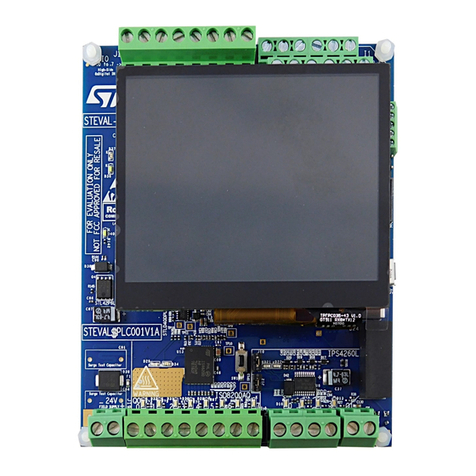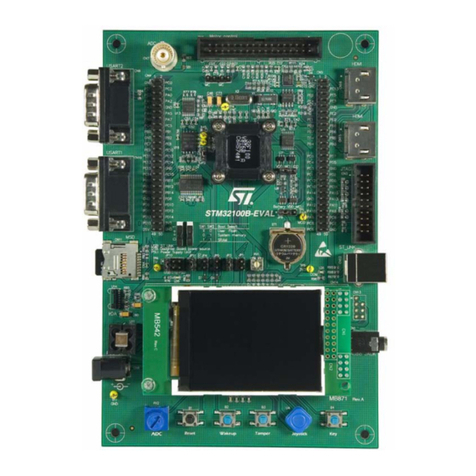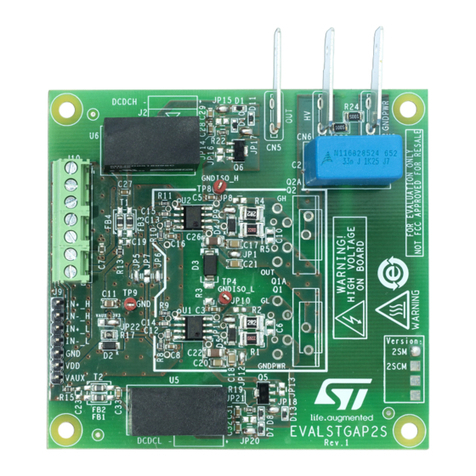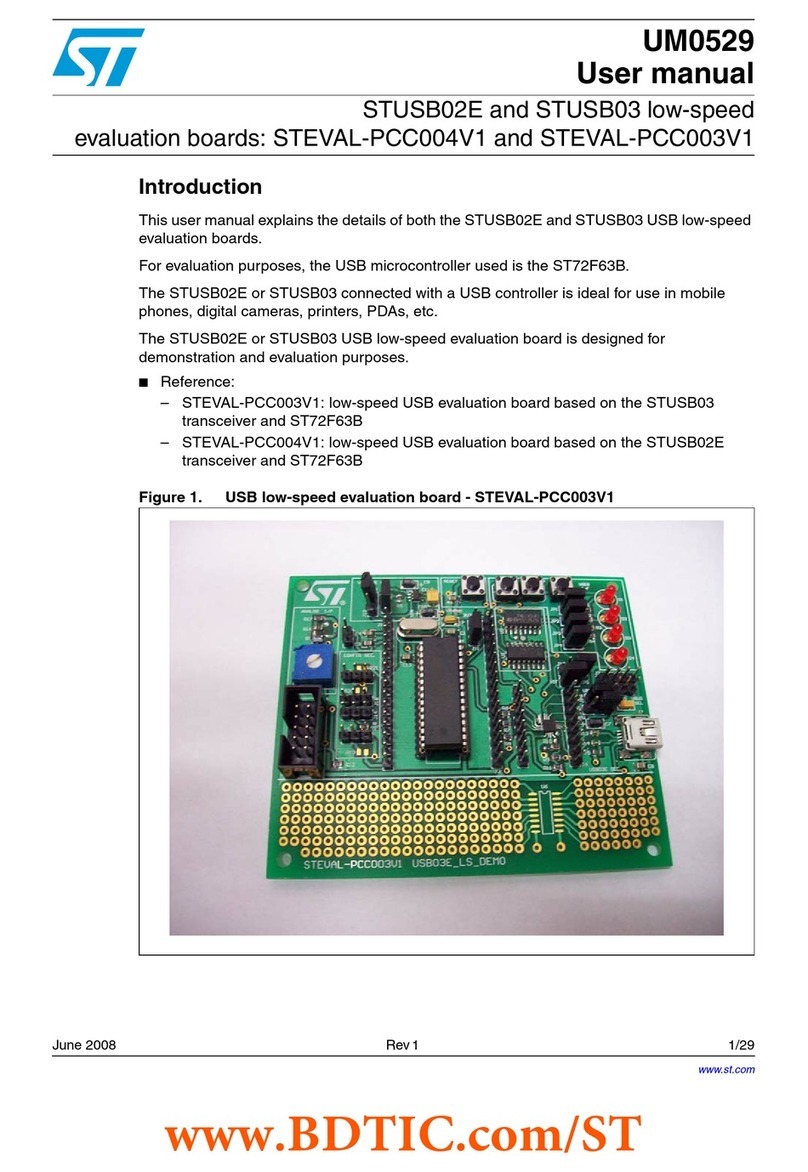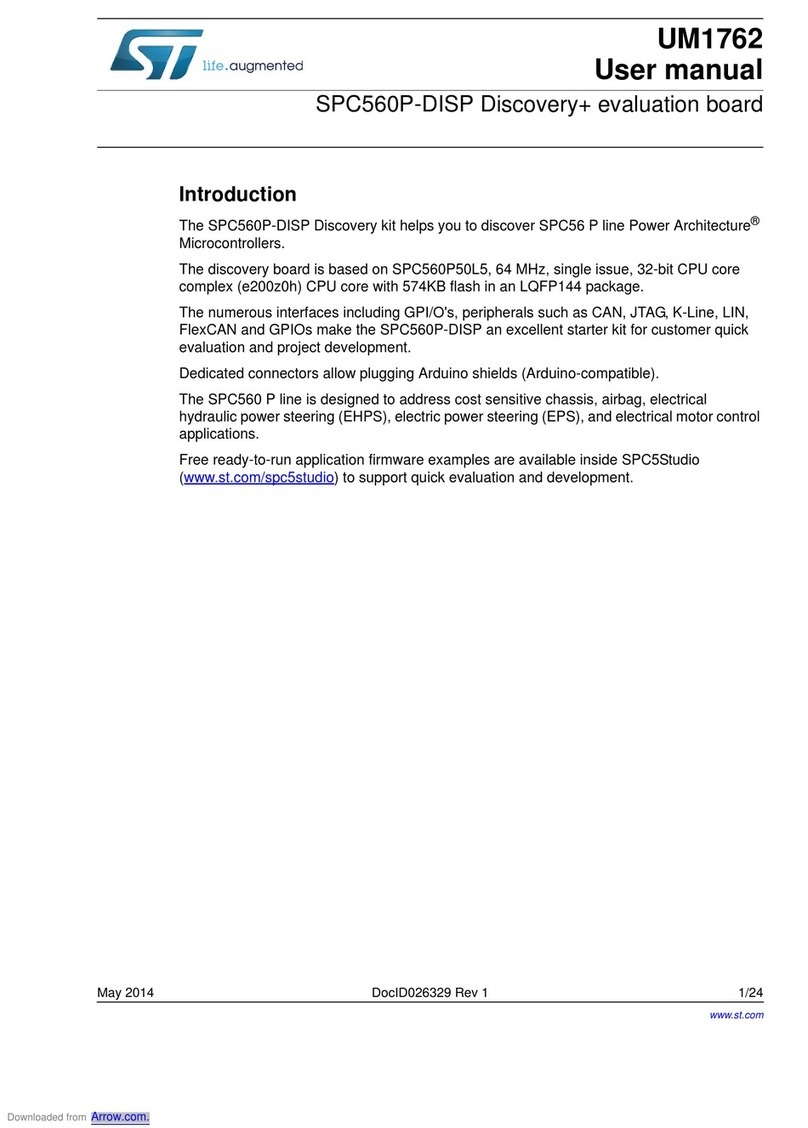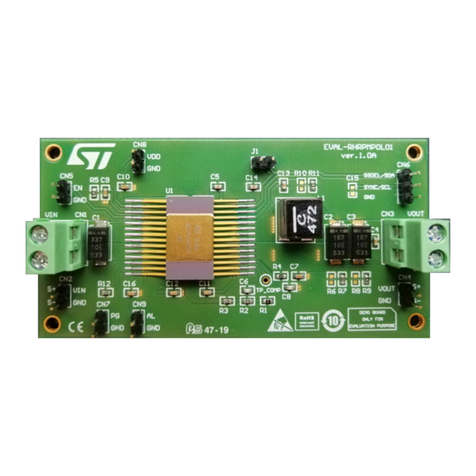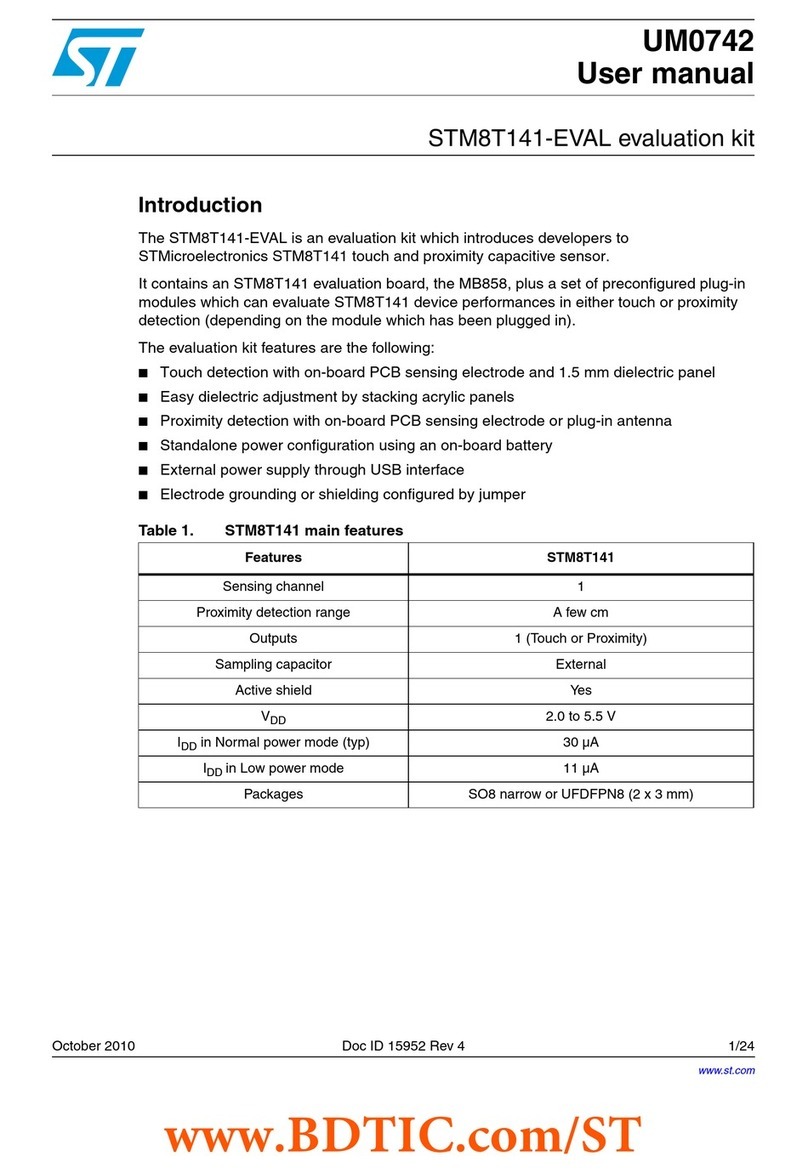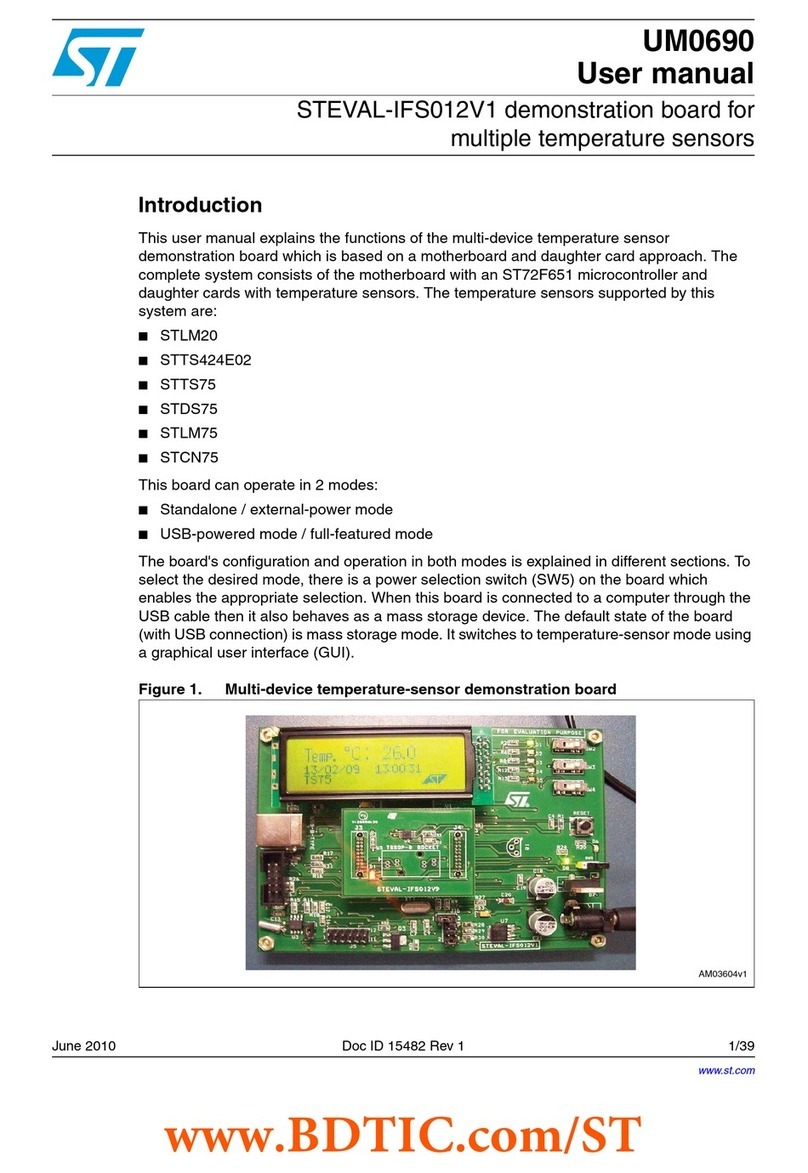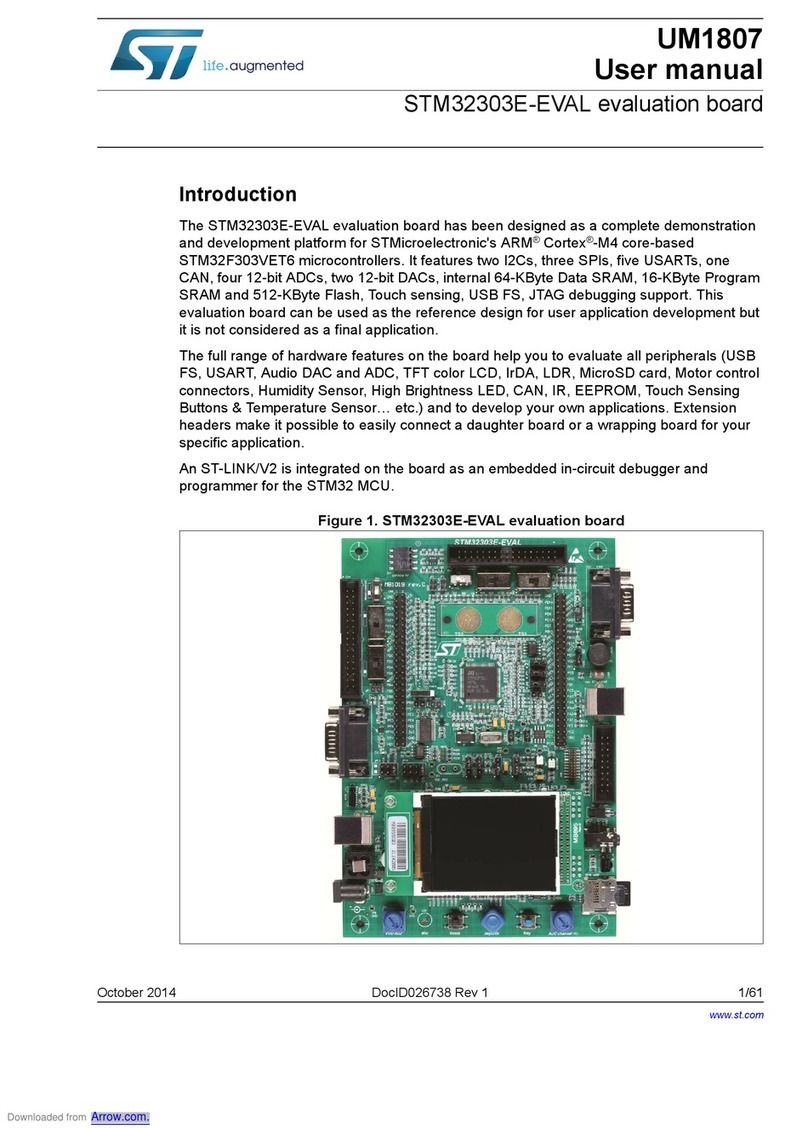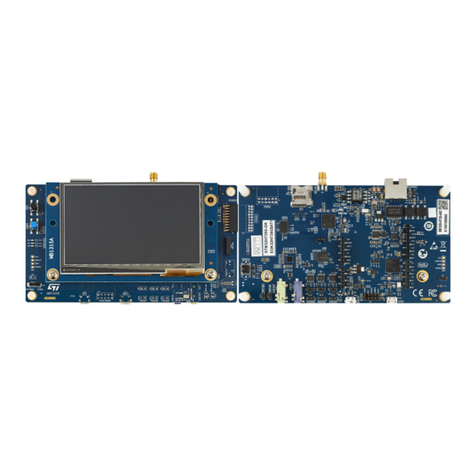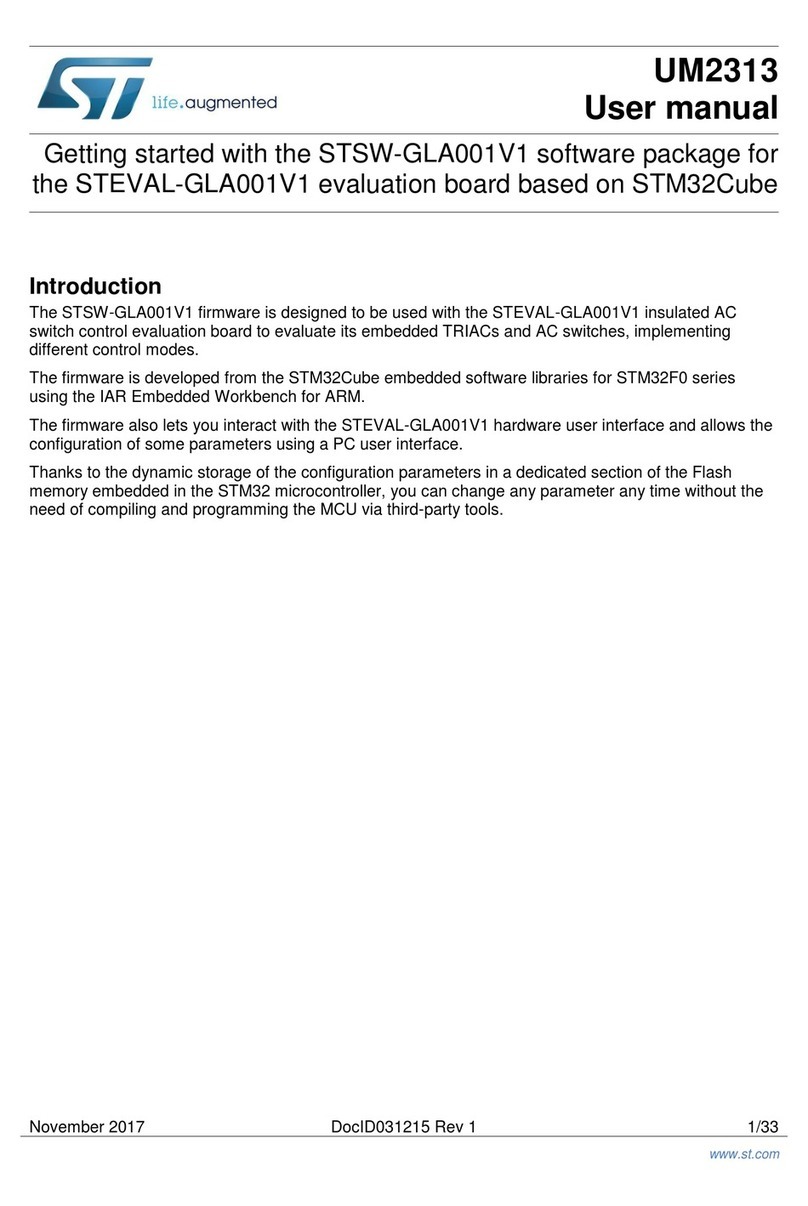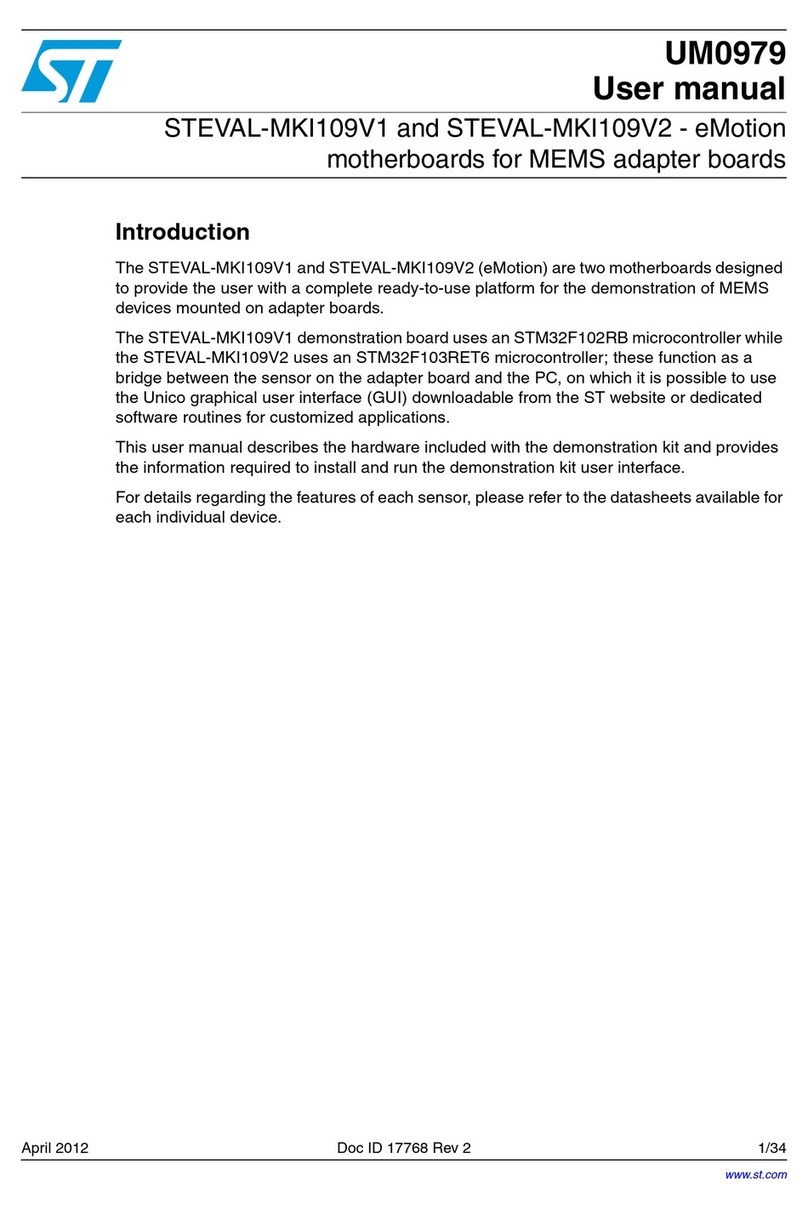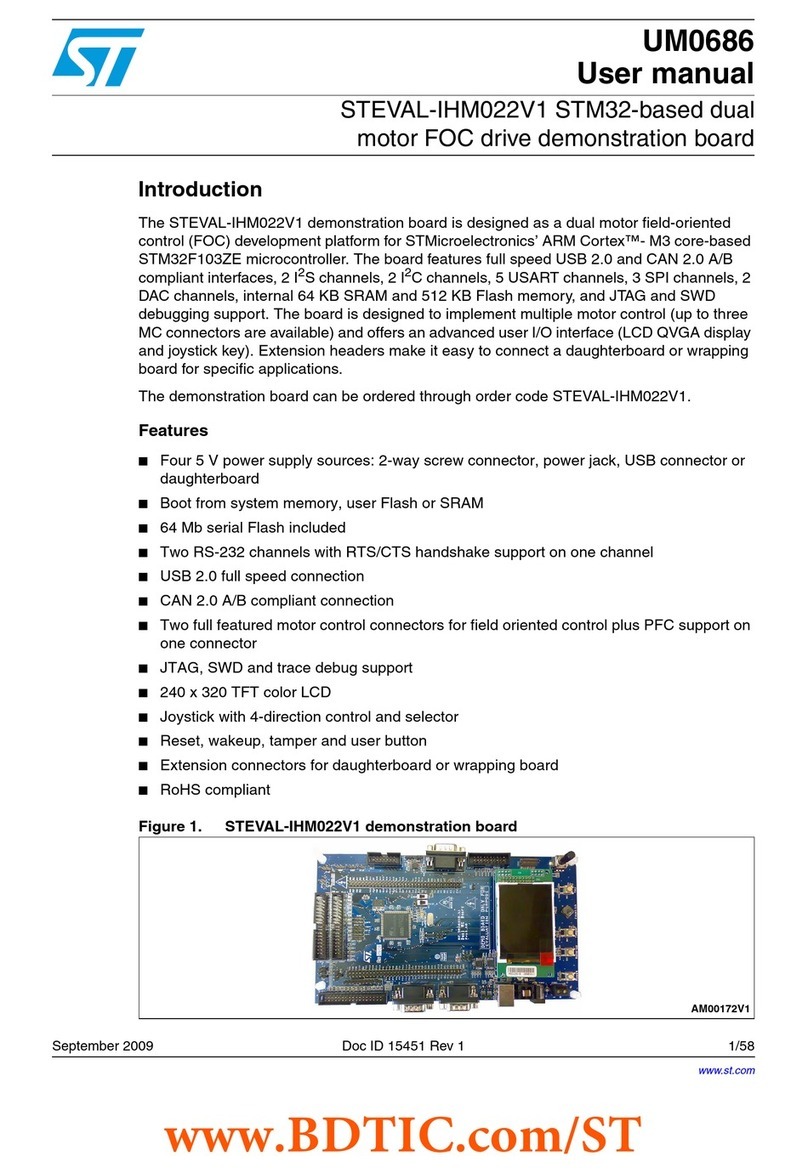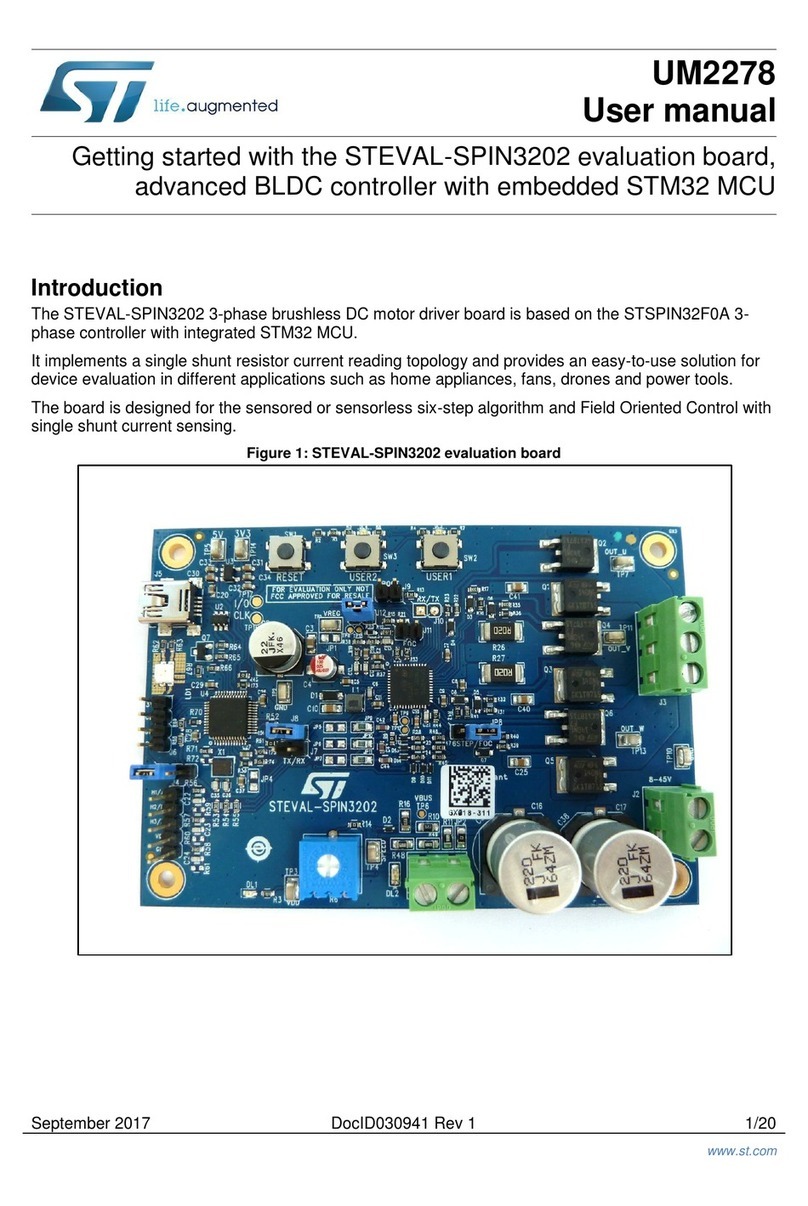
List of figures UM1903
6/79 DocID027919 Rev 2
List of figures
Figure 1. STM32756G-EVAL evaluation board . . . . . . . . . . . . . . . . . . . . . . . . . . . . . . . . . . . . . . . . . . 1
Figure 2. Hardware Block Diagram . . . . . . . . . . . . . . . . . . . . . . . . . . . . . . . . . . . . . . . . . . . . . . . . . . . 9
Figure 3. STM32756G-EVAL evaluation board layout. . . . . . . . . . . . . . . . . . . . . . . . . . . . . . . . . . . . 10
Figure 4. USB composite device . . . . . . . . . . . . . . . . . . . . . . . . . . . . . . . . . . . . . . . . . . . . . . . . . . . . 11
Figure 5. Orientation setting of the 5.7-inch LCD daughterboard . . . . . . . . . . . . . . . . . . . . . . . . . . . 26
Figure 6. STM32756G-EVAL evaluation board motor control PCB
reworks (Bottom side) . . . . . . . . . . . . . . . . . . . . . . . . . . . . . . . . . . . . . . . . . . . . . . . . . . . . . 27
Figure 7. STM32756G-EVAL evaluation board motor control PCB
reworks (Top side) . . . . . . . . . . . . . . . . . . . . . . . . . . . . . . . . . . . . . . . . . . . . . . . . . . . . . . . 28
Figure 8. Motor control connector CN1 (Top view) . . . . . . . . . . . . . . . . . . . . . . . . . . . . . . . . . . . . . . 30
Figure 9. RF-EEPROM daughterboard connector CN2 (Front view) . . . . . . . . . . . . . . . . . . . . . . . . . 31
Figure 10. Analog input-output connector CN3 (Top view) . . . . . . . . . . . . . . . . . . . . . . . . . . . . . . . . . 31
Figure 11. Camera module connector CN4 (Top view) . . . . . . . . . . . . . . . . . . . . . . . . . . . . . . . . . . . . 32
Figure 12. RS232 connector CN7 (Front view) . . . . . . . . . . . . . . . . . . . . . . . . . . . . . . . . . . . . . . . . . . 37
Figure 13. USB OTG HS Micro-AB connector CN8 (Front view) . . . . . . . . . . . . . . . . . . . . . . . . . . . . . 38
Figure 14. Ethernet RJ45 connector CN9 (Front view) . . . . . . . . . . . . . . . . . . . . . . . . . . . . . . . . . . . . 38
Figure 15. ETM Trace debugging connector CN12 (Top view) . . . . . . . . . . . . . . . . . . . . . . . . . . . . . . 42
Figure 16. USB OTG FS1 Micro-AB connector CN13 (Front view) . . . . . . . . . . . . . . . . . . . . . . . . . . . 42
Figure 17. USB OTG FS2 Micro-AB connector CN14 (Front view) . . . . . . . . . . . . . . . . . . . . . . . . . . . 43
Figure 18. JTAG/SWD debugging connector CN15 (Top view). . . . . . . . . . . . . . . . . . . . . . . . . . . . . . 43
Figure 19. MicroSD connector CN16 (Top view) . . . . . . . . . . . . . . . . . . . . . . . . . . . . . . . . . . . . . . . . . 44
Figure 20. Power supply connector CN17 (Front view) . . . . . . . . . . . . . . . . . . . . . . . . . . . . . . . . . . . 45
Figure 21. USB type B connector CN21 (Front view) . . . . . . . . . . . . . . . . . . . . . . . . . . . . . . . . . . . . . 46
Figure 22. CAN D-type 9-pin male connector CN22 (Front view) . . . . . . . . . . . . . . . . . . . . . . . . . . . . 46
Figure 23. MEMS microphone coupon connectors CN24 and CN27 (Top view). . . . . . . . . . . . . . . . . 47
Figure 24. SPDIF IN connector CN28 (Front view) . . . . . . . . . . . . . . . . . . . . . . . . . . . . . . . . . . . . . . . 48
Figure 25. STM32756G-EVAL evaluation board . . . . . . . . . . . . . . . . . . . . . . . . . . . . . . . . . . . . . . . . . 49
Figure 26. STM32756G-EVAL MCU . . . . . . . . . . . . . . . . . . . . . . . . . . . . . . . . . . . . . . . . . . . . . . . . . . 50
Figure 27. STM32756G-EVAL Power . . . . . . . . . . . . . . . . . . . . . . . . . . . . . . . . . . . . . . . . . . . . . . . . . 51
Figure 28. STM32756G-EVAL SRAM, Flash memory and DRAM . . . . . . . . . . . . . . . . . . . . . . . . . . . 52
Figure 29. STM32756G-EVAL Audio . . . . . . . . . . . . . . . . . . . . . . . . . . . . . . . . . . . . . . . . . . . . . . . . . 53
Figure 30. STM32756G-EVAL LCD, Camera and RF connector. . . . . . . . . . . . . . . . . . . . . . . . . . . . . 54
Figure 31. STM32756G-EVAL Ethernet . . . . . . . . . . . . . . . . . . . . . . . . . . . . . . . . . . . . . . . . . . . . . . . 55
Figure 32. STM32756G-EVAL USB OTG HS and OTG FS2 . . . . . . . . . . . . . . . . . . . . . . . . . . . . . . . 56
Figure 33. STM32756G-EVAL USB OTG FS1 . . . . . . . . . . . . . . . . . . . . . . . . . . . . . . . . . . . . . . . . . . 57
Figure 34. STM32756G-EVAL RS232 and IrDA . . . . . . . . . . . . . . . . . . . . . . . . . . . . . . . . . . . . . . . . . 58
Figure 35. STM32756G-EVAL CAN and QSPI . . . . . . . . . . . . . . . . . . . . . . . . . . . . . . . . . . . . . . . . . . 59
Figure 36. STM32756G-EVAL Peripherals . . . . . . . . . . . . . . . . . . . . . . . . . . . . . . . . . . . . . . . . . . . . . 60
Figure 37. STM32756G-EVAL Motor control . . . . . . . . . . . . . . . . . . . . . . . . . . . . . . . . . . . . . . . . . . . . 61
Figure 38. STM32756G-EVAL Extension connector . . . . . . . . . . . . . . . . . . . . . . . . . . . . . . . . . . . . . . 62
Figure 39. STM32756G-EVAL ST-LINK/V2-1 . . . . . . . . . . . . . . . . . . . . . . . . . . . . . . . . . . . . . . . . . . . 63
Figure 40. STM32756G-EVAL MFX . . . . . . . . . . . . . . . . . . . . . . . . . . . . . . . . . . . . . . . . . . . . . . . . . . 64
Figure 41. STM32756G-EVAL JTAG and Trace . . . . . . . . . . . . . . . . . . . . . . . . . . . . . . . . . . . . . . . . . 65
Figure 42. STM32756G-EVAL Camera daughterboard . . . . . . . . . . . . . . . . . . . . . . . . . . . . . . . . . . . . 66
Figure 43. STM32756G-EVAL 5.7 TFT LCD daughterboard . . . . . . . . . . . . . . . . . . . . . . . . . . . . . . . . 67
Figure 44. Mechanical dimensions . . . . . . . . . . . . . . . . . . . . . . . . . . . . . . . . . . . . . . . . . . . . . . . . . . . 76
